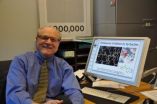(Press-News.org) (Boston) – A review article by researchers at Boston University School of Medicine (BUSM) proposes a new epigenetic hypothesis linked to tumor production and novel ideas about what causes progenitor cells to develop into cancer cells. Published in the February 2013 issue of Epigenomics, the article provides examples of how epigenetic drug treatments could be beneficial in treating cancers while also decreasing the likelihood of cancer relapse.
The article was written by researchers at the Boston University Cancer Center. Sibaji Sarkar, PhD, adjunct instructor of medicine at BUSM, is the article's corresponding author.
Cancer is a complex disease characterized by uncontrolled cell growth, division and invasion into other tissues. A 2004 review article published in Nature Medicine suggests that epigenetics, which is the phenomena whereby genetically identical cells express their genes differently resulting in different phenotypes and other factors play an important role in the formation of cancer originating from cancer stem cells.
Sarkar and colleagues propose that epigenetic processes, specifically DNA methylation, may trigger cancer progenitor cell formation from somatic cells in coordination with other cellular and environmental events. DNA methylation is a process that changes the DNA and causes genes to be silenced. In the absence of definitive proof of the existence of cancer stem cells, this hypothesis discusses a possible explanation for the formation and existence of cells that may develop into cancer. The researchers also explore why only some individuals develop cancer, despite identical genetic predispositions.
In cancer cells, the enzyme that maintains high levels of methylation in tumor suppressor genes is highly expressed, allowing uncontrolled growth. At the same time, many oncogenes, or genes with the potential to cause cancer, are activated and have lower levels of methylation. The apparent anomaly of the existence of both low and high rates of methylation could be explained with either the compartmentalization of these two processes and/or by the existence of both a methylation and demethylation system operating simultaneously at specific locations with the help of various accessory proteins.
The authors hypothesize the existence of both DNA methylating and demethylating enzymes in cells that regulate the methylation and demethylation process. Accessory proteins and/or small RNA factors could lead these enzymes to their sites of actions, resulting in some genes remaining methylated and others not methylated simultaneously within the same cellular environment. DNA sequences around the regions that are methylated and demethylated may also play role in these events. During drug treatments, the demethylating system dominates while the methylating enzyme is down-regulated, resulting in re-expression of silenced genes.
Recent studies have shown that epigenetic drug treatments prior to and with standard chemotherapy reduce the chance of cancer relapse.
"Progenitors are known to cause cancer relapse, and because epigenetic drugs can help destroy progenitor cells, these drugs could help reduce the chance of cancer relapse and improve the long-term outcomes of people with cancer," said Sarkar. "While our hypotheses are based on current knowledge, we are proposing important and exciting areas to be explored in the future."
###
Sarah Goldgar, Shannon Byler, Shoshana Rosenthal and Sarah Heerboth are co-authors of the article.
Research included in this review article was funded in part by the American Cancer Society.
BUSM authors propose potential epigenetic mechanisms for improved cancer therapy
2013-02-20
ELSE PRESS RELEASES FROM THIS DATE:
Infants in poverty show different physiological vulnerabilities to the care-giving environment
2013-02-20
Some infants raised in poverty exhibit physical traits that make them more vulnerable to poor caregiving, according to new research published in Psychological Science, a journal of the Association for Psychological Science. The combination of physiological vulnerability and poor caregiving may lead these children to show increased problem behaviors later in childhood.
For infants growing up in poverty, the ability to adapt and regulate — both biologically and behaviorally — in response to various environmental pressures seems to be critical for successful development.
To ...
Rewriting a receptor's role
2013-02-20
In a pair of new papers, researchers at the University of California, San Diego School of Medicine and the Royal Netherlands Academy of Arts and Sciences upend a long-held view about the basic functioning of a key receptor molecule involved in signaling between neurons, and describe how a compound linked to Alzheimer's disease impacts that receptor and weakens synaptic connections between brain cells.
The findings are published in the Feb. 18 early edition of the Proceedings of the National Academy of Sciences.
Long the object of study, the NMDA receptor is located ...
IU research: Rock-paper-scissors a parable for cycles in finance, fashion, politics and more
2013-02-20
BLOOMINGTON, Ind. -- Using a grown-up version of the rock-paper-scissors game, Indiana University cognitive scientists offer a new theory of the group dynamics that arise in situations as varied as cycles of fashion, fluctuations of financial markets, eBay bidding wars and political campaign strategies.
In a study written about this week in PLOS ONE, the researchers analyzed situations in which each person's decision depends on what they think other people will decide, looking at the riddle of "what you think I think you think I think."
What they found, said Seth Frey, ...
New compound holds high promise in battling kidney cancer
2013-02-20
RIVERSIDE, Calif. — Chemists at the University of California, Riverside have developed a compound that holds much promise in the laboratory in fighting renal (kidney) cancer.
Named TIR-199, the compound targets the "proteasome," a cellular complex in kidney cancer cells, similar to the way the drug bortezomib, approved by the Food and Drug Administration, targets and inhibits the proteasome in multiple myeloma cells, a cancer coming from bone marrow.
Michael Pirrung, a distinguished professor of chemistry at UC Riverside, announced the development of TIR-199 in a lecture ...
Diagnosis and treatment now possible for osteoarthritic cats
2013-02-20
VIDEO:
Scientists at the University of Montreal's Quebec Research Group in Animal Pharmacology have found a way to recognize and treat osteoarthritis in cats -- a condition that the owner might...
Click here for more information.
Scientists at the University of Montreal's Quebec Research Group in Animal Pharmacology have found a way to recognize and treat osteoarthritis in cats – a condition that the owner might not notice and that can make even petting painful. "Osteoarthritis ...
Stanford researchers develop tool for reading the minds of mice
2013-02-20
If you want to read a mouse's mind, it takes some fluorescent protein and a tiny microscope implanted in the rodent's head.
Stanford scientists have demonstrated a technique for observing hundreds of neurons firing in the brain of a live mouse, in real time, and have linked that activity to long-term information storage. The unprecedented work could provide a useful tool for studying new therapies for neurodegenerative diseases such as Alzheimer's.
The researchers first used a gene therapy approach to cause the mouse's neurons to express a green fluorescent protein ...
That's the way the droplets adhere
2013-02-20
CAMBRIDGE, MA -- Understanding exactly how droplets and bubbles stick to surfaces — everything from dew on blades of grass to the water droplets that form on condensing coils after steam drives a turbine in a power plant — is a "100-year-old problem" that has eluded experimental answers, says MIT's Kripa Varanasi. Furthermore, it's a question with implications for everything from how to improve power-plant efficiency to how to reduce fogging on windshields.
Now this longstanding problem has finally been licked, Varanasi says, in research he conducted with graduate student ...
Artful science
2013-02-20
There are "things hidden in plain sight" all around us. But art can help students see their world anew, unlocking discoveries in fields ranging from plant biology to biomedical imaging, according to University of Delaware professor John Jungck.
Jungck's sentiments were echoed by a panel of experts speaking on "Artful Science" on Feb. 15 at the annual meeting of the American Association for the Advancement of Science (AAAS) in Boston. Jungck organized the panel and also spoke at the event.
Canoeing on a lake near his home in northwestern Minnesota when he was a youngster, ...
Powerful people are looking out for their future selves
2013-02-20
Would you prefer $120 today or $154 in one year? Your answer may depend on how powerful you feel, according to new research in Psychological Science, a journal of the Association for Psychological Science.
Many people tend to forego the larger reward and opt for the $120 now, a phenomenon known as temporal discounting. But research conducted by Priyanka Joshi and Nathanael Fast of the University of Southern California Marshall School of Business suggests that people who feel powerful are more likely to wait for the bigger reward, in part because they feel a stronger connection ...
Engineering control theory helps create dynamic brain models
2013-02-20
BOSTON -- Models of the human brain, patterned on engineering control theory, may some day help researchers control such neurological diseases as epilepsy, Parkinson's and migraines, according to a Penn State researcher who is using mathematical models of neuron networks from which more complex brain models emerge.
"The dual concepts of observability and controlability have been considered one of the most important developments in mathematics of the 20th century," said Steven J. Schiff, the Brush Chair Professor of Engineering and director of the Penn State Center for ...



